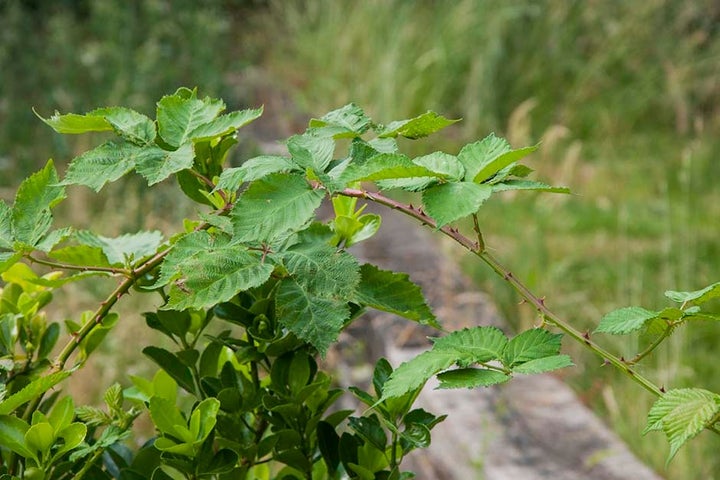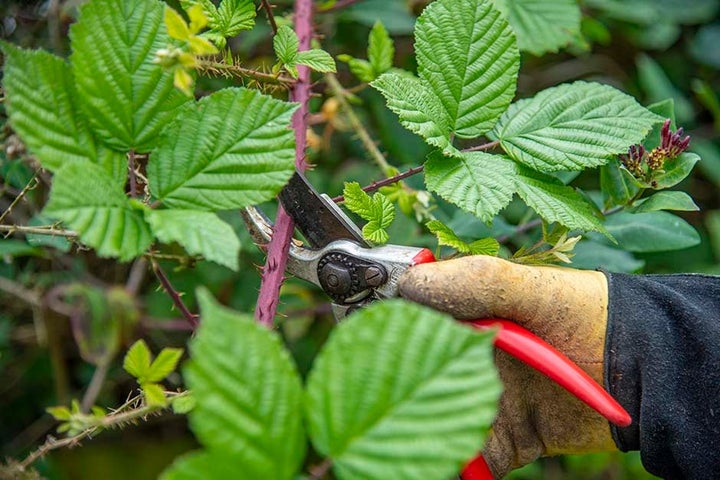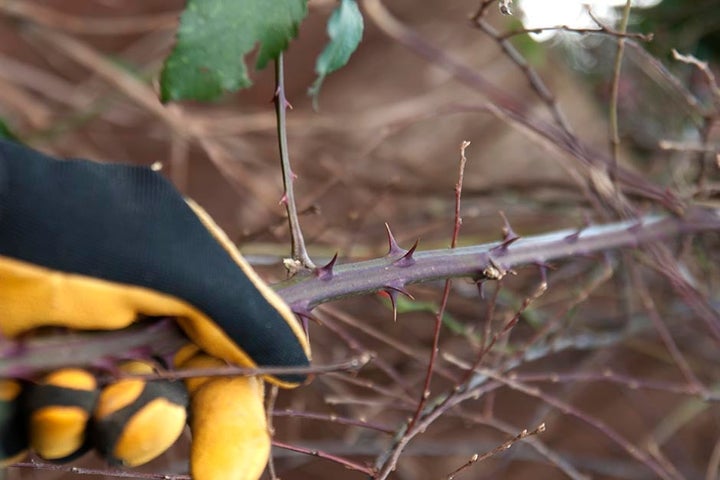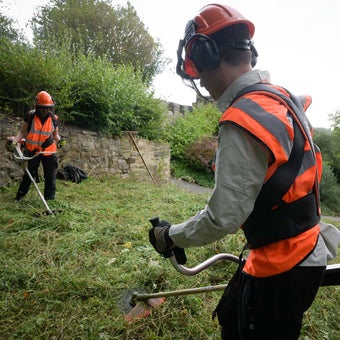
Quick facts
The botanical name for brambles is Rubus fruticosus; they are also commonly known as blackberries
Brambles are native to the UK and are found on woodland, scrub and waste ground
They provide food and shelter for many insects, birds and small mammals
With rooting stem tips, brambles can quickly spread to form a thicket of thorny branches
Brambles can be difficult to eradicate once established, requiring patience and persistence
What do brambles look like?
Brambles are scrambling, shrubs with thick, thorny, arching stems that can grow 1.8-2.5m (6-8ft) in length. They have dark green, deeply veined, toothed leaves with rounded leaflets; these turn orange and red in the autumn.
Between June and September, five-petalled pink or white flowers appear in clusters on the end of last year’s stems; they are the typical open saucer shape of plants in the rose family with a mass of central stamens. Flowers are followed by plump, edible, aromatic fruit which ripens from green to red to purplish-black.

Did you know?
There are over 2000 microspecies of Rubus, all with similar though slightly different leaf shapes, flower colours and fruit characteristics. They are collectively grouped as Rubus fruticosus agg. – the suffix being short for aggregate. This arises because brambles can produce fruit without being fertilised (they can clone themselves) through a process called apomixis, and the resultant fruit can carry mutations.
Are brambles weeds?
Brambles are fantastic for wildlife and are a food plant for a variety of insects including weevils, flies, leafhoppers, capsid bugs and beetles. They’re great for pollinators, providing pollen and nectar for bees and butterflies, including the holly blue, speckled wood and gatekeeper, as well as the pollinating Eurasian bee beetle and thick-legged flower beetle.
Brambles are particularly good for moths, with the Biological Records Centre listing almost 100 species, plus several micro moths, that use it as a food plant. These include numerous footman, pug and wave moths as well as the scarlet tiger, buff ermine and swallow-tailed moth.
Its dense, thorny stems provide shelter for a variety of small mammals, including hedgehogs and mice, as well as nest sites for many garden birds, including dunnocks, song thrushes and yellowhammers. These animals also eat the blackberries in late summer.

Top Tip
Check for nesting birds before you do any work to control or remove brambles. It is an offence under the Wildlife & Countryside Act 1981 to damage or destroy the nest of any wild bird while it is in use or being built. Nesting season generally lasts from March to August, but it may last longer for certain birds or those with multiple broods, so always check first.
Blackberries are also much loved, and ‘blackberrying’ is still a popular British pastime. The fruit is high in vitamin C and antioxidants and can be eaten raw, in drinks, or cooked in pies, crumbles, jellies and jams.
Did you know?
Brambles (Rubus fruticosus) are a parent plant of all cultivated blackberries and their hybrids. While it is possible to fan-train brambles for fruit, it is generally better to grow a cultivar, as these have been bred for improved fruit qualities and yield, thornless stems and a more manageable size. See our page on growing blackberries for more information.
However, the size and vigour of brambles means they are generally seen as weeds in most parts of a garden. They can quickly smother other plants and their sharp thorns makes them a hazard near pathways and in areas where children and pets play.
What is a weed?
The term ‘weed’ describes a plant that is growing where it isn’t wanted. Weeds usually thrive in average garden conditions, reproducing and spreading easily. It is up to you to decide what you call a weed and what you choose to retain or remove.
Frequently asked questions about controlling brambles
Here are our answers to your most common questions about dealing with brambles:
How invasive are brambles?
Brambles spread primarily by tip layering, where their long, arching stems root on contact with the ground to form new plants. Brambles also produce seed, contained within their characteristic berries, which can be deposited in gardens inside animal droppings. And, as their roots can regenerate from small sections, gardeners may unintentionally spread brambles by composting roots or chopping them up when digging.
Brambles establish and grow quickly, and newly-rooted stems and soon start to send up their own scrambling stems. If not spotted and controlled promptly, brambles can quickly develop into dense tangles.

Do I need to get rid of brambles?
Not necessarily – allowing them to grow in a wildlife garden, woodland or less-cultivated area is a great way to boost the of your garden and support your garden’s wildlife, as well as giving you the chance to harvest the tasty fruits.
It is, however, a good idea to control the spread of any bramble plants you wish to keep, to stop them growing into cultivated areas where they could smother other plants or become a hazard.
What is the easiest way to kill brambles?
If you have brambles growing where they are not wanted, there are a few ways to remove them:
- borders – cover bare soil in beds and borders with a 7.5cm (3in) deep layer of organic matter in late winter or early spring. This makes it easier to pull out bramble seedlings.
- Pull or fork out seedlings – promptly remove any bramble seedlings that appear in spring, before they have a chance to get established.
- Keep in check – if you have brambles that you are happy to keep (for wildlife or their harvest), or there are brambles on neighbouring land which you can’t remove, curtail their spread by regularly shortening the long stems. This prevents them rooting into the soil and spreading further. Be sure to only shorten stems back to your boundary (as it is illegal to damage any outside of your own garden) and dig up any stems that have already rooted. Wear thick gloves to protect yourself from the sharp thorns.
- Cut back and dig out established plants – shorten all stems to around 30cm (1ft) from ground level, using loppers, a hedge trimmer or a brush cutter. If the brambles have grown into shrubs or hedges, or are in a dense tangle, you may need to cut the stems in several places and pull sections to clear them. Once all stems are cut and cleared, use a sharp spade and border fork to dig out the main stump and as many roots as possible. Monitor the area for regrowth over the growing season, digging out any new stems that appear.


Top Tip
If you are clearing a large area of brambles, consider shredding the stems to create a mulch for pathways or using the long lengths to create a dead hedge for wildlife. However, it is best not to put any roots, seedlings or whole lengths of stem in your home compost bin as it may not reach high enough temperatures to kill them. Instead, put them in your council green waste recycling bin or take them to your local recycling site.
Should I use weedkiller?
No – although brambles can be tricky to completely eradicate, often requiring time and patience, non-chemical controls are effective.
The RHS does not support the use of weedkillers and recommends that alternative control methods are used. However, we do note that when gardeners struggle to control plants with cultural methods, regulated weedkillers/pesticides for home gardeners are available for use legally. Garden centres and large retailers selling weedkillers have trained staff who can advise on suitable products for your needs.




















